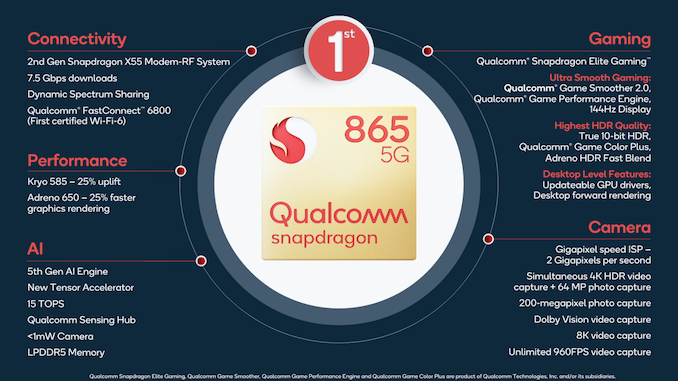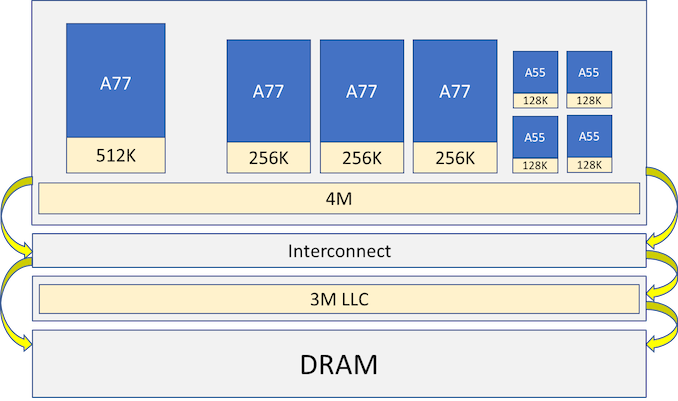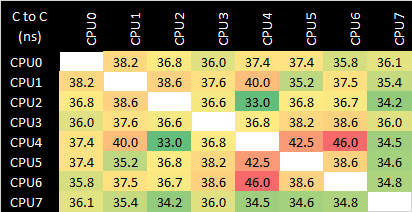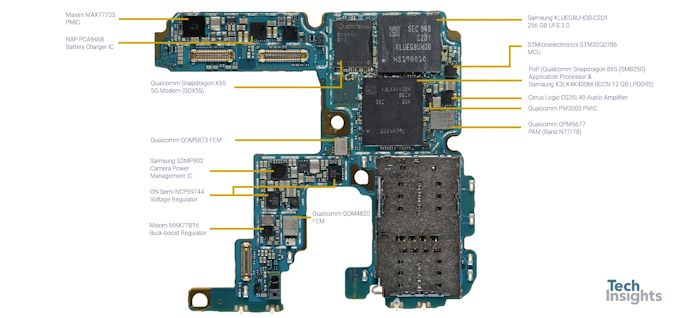The Samsung Galaxy S20+, S20 Ultra Exynos & Snapdragon Review: Megalomania Devices
by Andrei Frumusanu on April 3, 2020 9:30 AM ESTThe Snapdragon 865 SoC: Beating Expectations
We’ve covered the Snapdragon 865 extensively over the last few months, and more recently did a performance preview of the chip on the Galaxy S20 Ultra:
-
Qualcomm Announces Snapdragon 865 and 765(G): 5G For All in 2020, All The Details
-
The Snapdragon 865 Performance Preview: Setting the Stage for Flagship Android 2020
-
Samsung Galaxy S20 Ultra (Snapdragon 865) Quick Performance Preview: Impressive
It’s safe to say that Qualcomm managed to beat our expectations in terms of power efficiency improvements. Which is something we’ll go over in more detail in this piece as well.
At the heart of the Snapdragon 865 we find Arm’s newest Cortex-A77 CPU cores. The new microarchitecture is said to bring a 20-25% IPC improvement over its predecessors, and that’s where the new SoC derives most of its performance improvements from, as the clock frequencies of the cores are identical to that of last year’s Snapdragon 855.
One aspect where Qualcomm did improve the design is in doubling the shared L3 cache of the CPU cluster, going from 2MB to 4MB. Not only does this further improve the performance of the CPUs by allowing for more data to be cached on-chip, but Qualcomm has explained that one of the primary reasons for this was to also improve power efficiency of the SoC by reducing how often the SoC has to access the DRAM, which is a relatively power-expensive operation.
The chip still has a 3MB system level cache that serves the various IP blocks on the SoC – it’s again meant to not only improve performance but also improve power efficiency as it avoids external memory accesses. The memory subsystem here is smart and detects when to bypass this cache when there’s latency-sensitive workloads, and in general we’ll see some massive memory subsystem improvements on the part of the Snapdragon 865 in a later dedicated section.
All the CPUs being in the same cluster and cache hierarchy means that the core-to-core latencies are relatively uniform, only differing based on their frequencies and lower level cache access latencies. It’s not too much of an exciting metric here, but it’s important context to have as we’ll consider the Exynos 990’s CPU topology in just a bit.
Again, we’ve covered the Snapdragon 865 quite extensively in the above linked articles so I recommend reading them again for other details on other parts of the new chip, such as the new ISP, DSP, and GPU details. However, one aspect that’s very defining for the flagship Qualcomm chipset this year is that the company is separating the modem from the SoC – essentially making the SoC just an application processor for this generation.
The external nature of the X55 modem has a few implications: first of all, there’s an additional component on the motherboard which vendors will have to make space for, which means additional cost. Secondly, there’s the big question of how power efficiency will be affected by the external modem. We’ve seen Apple devices perform excellently over the years while never having an integrated modem, and I feel like the Snapdragon 865 and X55 also fall into this classification, as I haven’t seen any major differences in efficiency due to the external nature of the modem.














137 Comments
View All Comments
StrangerGuy - Wednesday, April 8, 2020 - link
$1400? Geez, I thought $1100 for the Ultra here in Singapore was already stupid overpriced especially when all S20 variants here are only available in 128GB and the Note 10+ 256GB is just $590.Cliff34 - Friday, April 3, 2020 - link
When I upgraded from s3 to s7, I was so impress by the new phone. Long battery life, great camera and fast cpu.Now I upgraded to s20+ and instead of feeling the aww feeling, I'm more like meh.
It comes w great features but they are all come w a cost. Great camera but if you take 64meg photos, it takes a few seconds to process. Great screen but if you switch on 120 hertz, your battery drains fast.
Hindsight, s20 is good enough for me.
philehidiot - Friday, April 3, 2020 - link
This is why I simply won't buy a new phone until I've waited for the Anandtech review. It takes a long time to come out and even longer to read but it has saved me a few bad decisions and premature upgrades. As well as a tonne of cash. I'm still on my S8 and the missus is on the S7 and y'know what? They're just fine. My only issue with the S8 is a recent update which is resulting in markedly increased screen brightness when set to auto. Try and drag the brightness back down and it just goes back up again. I can only imagine that "feature" was added to convince people it's time to upgrade. The only other issue is a bit of lag here and there but it's not a massive issue. I'm in the UK, so I absolutely will NOT pay Samsung for a product that is so inferior to other markets but they market and expect me to value exactly the same. I'm no problem with different internals for different markets and I've no problem with parts being sourced from different suppliers. BUT, you either change the price to reflect the value or you keep the specs of the different parts near enough the same if you want the value to be the same.Now, if you'll excuse me, for some strange reason my middle finger has gone stone cold and needs a rest. As if the blood has drained from it as a result of spending so much time erected in Samsung's direction.
phoenix_rizzen - Friday, April 3, 2020 - link
Install Lux and let that manage the auto-brightness. On the S6, S7, and A8 (2018), Lux does a much better job managing brightness than Samsung's settings. And you can set your own targets for "at this level of ambient light, set the brightness to this level", which is especially handy for lower light levels.On the S10e, I haven't bothered to install Lux, as Samsung's Adaptive Brightness eventually catches up to my preferences and is working well enough.
philehidiot - Friday, April 3, 2020 - link
Ahh sweet, cheers! I'll have a look at that now. The adaptive brightness has worked fine for several years and only since an update has it gone very strange.shabby - Friday, April 3, 2020 - link
Can all the cameras on the s20+ record in 4k60fps? In the s10 only the main one could so you couldn't record in 4k60 while switching between the sensors.Andrei Frumusanu - Friday, April 3, 2020 - link
It's unfortunately still only limited to the main camera module.shabby - Friday, April 3, 2020 - link
Damnitiamlilysdad - Friday, April 3, 2020 - link
While waiting for display accuracy comparison charts, can you post "old style" dE results so we can do our own comparisons? Or, even better, provide a timeline and list of devices that you're going to go back and retest using the new methodology/rating system?FunBunny2 - Friday, April 3, 2020 - link
I'm not a phone junkie, doh!, but isn't refresh rate tied to content/application coding? IOW, only content/applications written to display at 120 will benefit? Otherwise, won't the screen just refresh twice on the 60hz line?